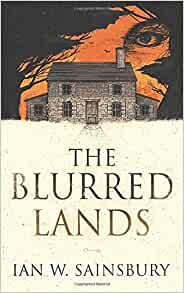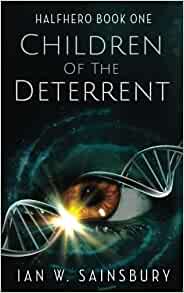Ian W Sainsbury on embracing a new genre
Interview by: Jim Sullivan, 15/01/2020
Ian W Sainsbury is best known for his science fiction books, so 'The Picture On The Fridge' - which won the £20k Kindle Storyteller Award 2019 - is a debut psychological thriller from an experienced hand.

Questions about writing
I understand that you dictate your first drafts and then edit what the computer transcribes? How efficient do you find this process? It sounds as if you would need to have the complete story well worked out before you start – could you talk a little about how this works?
Ian: My process has changed from book to book. I dictated most of the first draft of the Fridge, but I’m back at the keyboard for the next two. I’ll try dictating again soon, though, as it worked well. It made no difference to the planning stage. I start with a ‘big picture’ idea of where I’m going, including an ending (which always changes). When I’m writing the first draft, I just sketch out the next two or three scenes in a paragraph or two. Once that’s done, it doesn’t make any difference if I’m writing or dictating. If I’m dictating, the transcription is done before I start the next section.
I’ve heard writers say they don’t dictate because they associate writing too strongly with sitting at a keyboard. I can vouch for the fact that it’s an easy habit to break. Writing happens in the brain. Dictating is a good choice for a first draft, particularly the way I did it—away from the computer—because there’s no way I could tweak what I’d just written until it was transcribed. I was forced to keep moving forwards.
Your latest book is also your debut as a thriller writer. How did you find the experience of meeting the expectations of a different genre?
Ian: I didn’t think too hard about it. I love a good thriller, so I tried to write a story that I’d find exciting. That’s all I’ve done for every book, regardless of genre. I’m a reader first, so I want to write stories I would love to read. I think my first book,The World Walker, was a thriller at heart, as were most of the others, although they were SF. The Picture On The Fridge does the same thing with fewer aliens.
Could you talk a little about your journey into writing? Judging by the postbag, quite a few of our readers are closet writers who need some encouragement before they’ll let the world see their work. How difficult was this for you in the early days, does it still cause you anxiety when you release a new title . . . any advice for those closet authors?
Ian: Authors are a curious breed. Lots of people write, and dream of being an author. If you’re already writing, you’ve taken the most significant step. Now you have to finish what you’re writing, and put it in front of readers. Art doesn’t exist in a vacuum. Having said that, I’m not belittling how hard it can be to take that final step. I have never released a book without first having a few trusted people read it (even when I choose to ignore some of their opinions!) Yes, I still fret when I let a new story out into the wild, but what’s the point of all the hours of work if I’m not going to share it?
Writing is a craft, and you learn it by doing it. If self-doubt and anxiety is stopping you, use a pen name. No one need know you’ve written a book. Getting a good review from someone you’ve never met is a wonderful thing.
I love a good thriller, so I tried to write a story that I’d find exciting. That’s all I’ve done for every book, regardless of genre
What’s a typical writing cycle like for you? How many drafts and rewrites, how much time before you start writing . . . every author we speak with seems to handle this stuff differently.
Ian: I have no shortage of ideas, but I spend a few weeks deciding which one is the strongest before starting. Then I write a very very rough outline - maybe a scribbled page of A4. After that I write the first draft in Scrivener. Six days a week is 12-15,000 words for me. In six to eight weeks I have a draft. If I’m self-publishing, I give it a few days (can’t afford the six weeks Stephen King recommends) then trim and polish. I use an app called ProWritingAid to help me identify weak spots, over-used words etc. Then I have one or two outside editors go through it, including Mrs S. I’ll brief my cover designer at this point. Two or three beta readers get it next, but only to identify any plot holes or problems that might have been missed. Then I format it in Vellum, finalise the cover, write the blurb, upload it and email my mailing list. Three-six drafts in all.
Getting a good review from someone you’ve never met is a wonderful thing
You’re part of the growing wave of independent authors. Could you get your crystal ball out and give us some predictions for how publishing will change in the coming years?
Ian: People who make predictions in print are asking to look like an idiot pretty quickly. Having said that…I think we’ll see more hybrid authors over the next few years, with one foot in self-publishing and another in trad. I also think we’ll see an influx of small, agile e-publishers offering distribution and marketing to indy authors, and able to keep up with the pace at which we can work. I want to write three books a year, and that’s sluggish by many authors’ standards. I also hope we’ll see TV and movie production companies developing projects based on indy books.
Even in ‘The Picture On The Fridge’ – a tense, dark thriller – sparks of humour poke through, as if you just can’t help yourself. Could you talk a little about humour in writing (and life)?
Ian: It’s true, I can’t help myself. I believe humour belongs in even the darkest situations. Life is unfair, dangerous, and scary, so I prefer to point a finger at it and blow raspberries rather than cower in a corner. Humour is one of the finest ways in which we assert our humanity, especially when we laugh at ourselves. And the British have such a rich store of swearwords. How can anyone get through life without being able to occasionally say—with great passion—bollocks?
Questions about The Picture On The Fridge
Always tricky with a thriller, but could you give us a brief teaser (without giving the game away)?
Ian: Why is an eleven-year-old girl in London drawing detailed pictures of murder scenes in America…before the crimes are committed?
Your main character, Mags, is a troubled woman. How much of a stretch was it to write from a woman’s perspective?
Ian: I’m not sure there should be a difference. I’m me, no-one else: every character is a piece of fiction. As a reader, and a writer, I’m interested in character. What makes someone think, and act, a certain way? How might someone behave under extreme pressure? I don’t think too hard about their gender. Mags happened to be a woman. Conversely, when I read classics to my youngest daughter, she always asks, “where are the strong female charcters?” I don’t want her asking that question when she reads my books. My next two novels will have female protagonists. I also have written, and will write, characters of colour, gay characters, trans characters, non-binary characters. How can a story feel real if certain groups are excluded?
The Picture On The Fridge feels readily adaptable to the screen. Did you ‘see’ it as a movie when you were writing?
Ian: Absolutely, I write visually, in scenes. I’m a sucker for a great movie.
Some of Ian's other books:
Posted in: crime-thrillers-mystery science-fiction-fantasy













